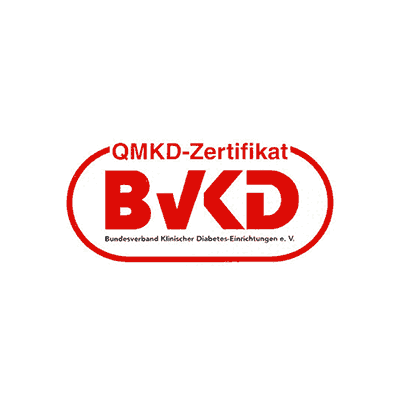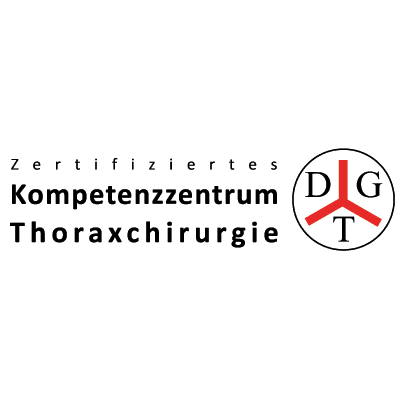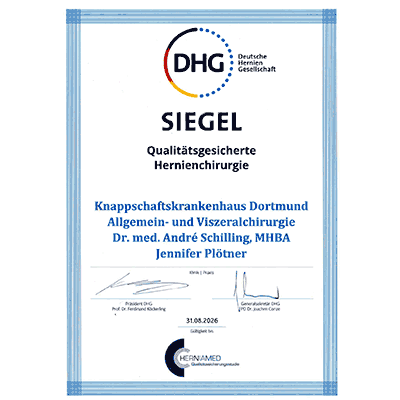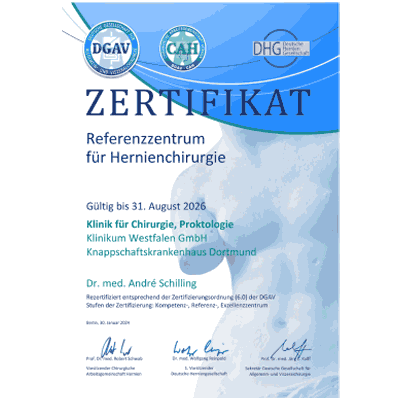PSMA-Therapie bei metastasierten Prostatakarzinomen
Was ist die PSMA-Therapie und wozu wird sie eingesetzt?
Krebszellen, die von der Prostata ausgehen, tragen in der Regel auf ihrer Zelloberfläche das Prostata-spezifische Membran-Antigen (PSMA). Dieses Membranantigen dient wie ein Magnet als Andockstelle für bestimmte Peptide, die sogenannten PSMA-Liganden. Diese werden mit einem therapeutisch wirksamen Betastrahler, Lutetium-177, radioaktiv markiert.
Da das Eiweißmolekül spezifisch an das PSMA der Tumorzellen bindet, reichert sich die Therapiesubstanz nach der Injektion im Tumor an. Die Therapiesubstanz gelangt über die Blutbahn direkt zum Tumorgewebe und führt zu einer gezielten Bestrahlung der bösartigen Zellen. Dabei reicht die radioaktive Strahlung im menschlichen Gewebe nur wenige Millimeter weit. Bei der PSMA-Therapie kann somit eine höhere und effektivere Strahlendosis direkt gegen die Krebszellen gerichtet werden, als es bei der externen Strahlentherapie der Fall ist.
Verschiedene klinische Studien zeigen, dass die PSMA-Therapie das Wachstum von Tumoren bremsen oder sie stark verkleinern kann. Durch die Therapie können sich Schmerzen reduzieren, der PSA-Wert sinken und die Lebensqualität signifikant verbessert werden.
Lu-177-PSMA erhielt im März 2022 eine FDA-Zulassung und im Dezember 2022 eine EMA-Zulassung zur Therapie des metastasierten kastrationsresistenten Prostatakarzinoms nach Fortschreiten des Tumors unter neuartiger antihormoneller Therapie und Chemotherapie mit Taxanen.
Da das Eiweißmolekül spezifisch an das PSMA der Tumorzellen bindet, reichert sich die Therapiesubstanz nach der Injektion im Tumor an. Die Therapiesubstanz gelangt über die Blutbahn direkt zum Tumorgewebe und führt zu einer gezielten Bestrahlung der bösartigen Zellen. Dabei reicht die radioaktive Strahlung im menschlichen Gewebe nur wenige Millimeter weit. Bei der PSMA-Therapie kann somit eine höhere und effektivere Strahlendosis direkt gegen die Krebszellen gerichtet werden, als es bei der externen Strahlentherapie der Fall ist.
Verschiedene klinische Studien zeigen, dass die PSMA-Therapie das Wachstum von Tumoren bremsen oder sie stark verkleinern kann. Durch die Therapie können sich Schmerzen reduzieren, der PSA-Wert sinken und die Lebensqualität signifikant verbessert werden.
Lu-177-PSMA erhielt im März 2022 eine FDA-Zulassung und im Dezember 2022 eine EMA-Zulassung zur Therapie des metastasierten kastrationsresistenten Prostatakarzinoms nach Fortschreiten des Tumors unter neuartiger antihormoneller Therapie und Chemotherapie mit Taxanen.
Wie läuft die PSMA-Therapie ab?
Zuerst sollte eine ausreichende Speicherung des PSMA-Tracers in den Tumorläsionen dokumentiert sein, um ein Ansprechen auf die Behandlung wahrscheinlicher zu machen. Dies erfolgt mittels einer PSMA-Bildgebung (z.B. PSMA PET/CT).
Im Rahmen eines ambulanten Vorgesprächs in unserer Nuklear-Onkologischen Ambulanz wird die Indikation für eine PSMA-Therapie fachärztlich geprüft. Bitte bringen Sie Ihre aktuellen Arztberichte und Laborwerte sowie, falls vorhanden, die CDs der letzten Bildgebungen mit. Falls noch keine PSMA-Bildgebung durchgeführt wurde, werden wir diese für Sie organisieren. Ambulant wird zudem eine Nierenszintigraphie zum Ausschluss einer Nierenfunktionsstörung und einer relevanten Harnstauung durchgeführt. In Abhängigkeit von der Bildgebung, den Blutwerten und der Nierenfunktion wird die Vorgehensweise für die PSMA-Therapie bestimmt.
Die Therapie findet auf unserer Therapiestation statt. Die Applikation des radioaktiven Arzneimittels dauert etwa eine Minute. Zur Vermeidung von Nebenwirkungen erfolgt die Gabe von Flüssigkeitsinfusionen und gegebenenfalls Kortikosteroiden. Außerdem werden die Speicheldrüsen mittels Kühlpackungen gekühlt. Insgesamt wird Ihre Behandlung etwa fünf Stunden in Anspruch nehmen.
In den folgenden Tagen werden szintigraphische Ganzkörperaufnahmen sowie SPECT/CTs durchgeführt, um die Speicherung von Lutetium-177 in den Tumorzellen zu kontrollieren.
Nach der Behandlung strahlt ein Teil der radioaktiven Substanz noch für eine gewisse Zeit vom Patienten nach außen. Um eine Gefährdung für Ihr Umfeld durch diese Strahlung auszuschließen, müssen Sie nach Strahlenschutzvorgaben im Anschluss an die Behandlung mindestens 48 Stunden auf der nuklearmedizinischen Station der Klinik verbleiben. Ihre ärztliche Fachkraft in der Klinik für
Nuklearmedizin wird Sie über den genauen Ablauf und die Dauer der Behandlung informieren.
Die PSMA-Therapie mit Lu-177-PSMA-617 ist für sechs Therapien in etwa 6- bis 8-wöchigen Abständen zugelassen.
Im Rahmen eines ambulanten Vorgesprächs in unserer Nuklear-Onkologischen Ambulanz wird die Indikation für eine PSMA-Therapie fachärztlich geprüft. Bitte bringen Sie Ihre aktuellen Arztberichte und Laborwerte sowie, falls vorhanden, die CDs der letzten Bildgebungen mit. Falls noch keine PSMA-Bildgebung durchgeführt wurde, werden wir diese für Sie organisieren. Ambulant wird zudem eine Nierenszintigraphie zum Ausschluss einer Nierenfunktionsstörung und einer relevanten Harnstauung durchgeführt. In Abhängigkeit von der Bildgebung, den Blutwerten und der Nierenfunktion wird die Vorgehensweise für die PSMA-Therapie bestimmt.
Die Therapie findet auf unserer Therapiestation statt. Die Applikation des radioaktiven Arzneimittels dauert etwa eine Minute. Zur Vermeidung von Nebenwirkungen erfolgt die Gabe von Flüssigkeitsinfusionen und gegebenenfalls Kortikosteroiden. Außerdem werden die Speicheldrüsen mittels Kühlpackungen gekühlt. Insgesamt wird Ihre Behandlung etwa fünf Stunden in Anspruch nehmen.
In den folgenden Tagen werden szintigraphische Ganzkörperaufnahmen sowie SPECT/CTs durchgeführt, um die Speicherung von Lutetium-177 in den Tumorzellen zu kontrollieren.
Nach der Behandlung strahlt ein Teil der radioaktiven Substanz noch für eine gewisse Zeit vom Patienten nach außen. Um eine Gefährdung für Ihr Umfeld durch diese Strahlung auszuschließen, müssen Sie nach Strahlenschutzvorgaben im Anschluss an die Behandlung mindestens 48 Stunden auf der nuklearmedizinischen Station der Klinik verbleiben. Ihre ärztliche Fachkraft in der Klinik für
Nuklearmedizin wird Sie über den genauen Ablauf und die Dauer der Behandlung informieren.
Die PSMA-Therapie mit Lu-177-PSMA-617 ist für sechs Therapien in etwa 6- bis 8-wöchigen Abständen zugelassen.
Wie reagiert Ihr Körper auf die PSMA-Therapie?
Bisherige Ergebnisse zeigen, dass keine schwerwiegenden, akuten Komplikationen zu befürchten sind. Trotz größter Sorgfalt können bei der PSMA-Therapie jedoch Nebenwirkungen auftreten.
Mögliche Nebenwirkungen und Komplikationen:
Mögliche Nebenwirkungen und Komplikationen:
- Gelegentlich Übelkeit, Erbrechen und Appetitlosigkeit
- Gelegentlich Temperaturerhöhung, sehr selten Fieber im Anschluss an die Therapie
- Gelegentlich Müdigkeit und Abgeschlagenheit (können bis wenige Wochen nach der Therapie andauern)
- Die Zahl der Blutzellen kann nach der Therapie abnehmen. Deshalb muss das Blutbild in den ersten zwei Monaten nach der Therapie zweiwöchentlich kontrolliert werden.
- Bei mehrmaliger Therapie könnte es bei einigen Patienten zu einer Einschränkung der Nierenfunktion kommen, weshalb diese vor jeder Therapie untersucht wird.
- Bei mehrmaliger Therapie kann es bei einigen Patienten zu einer Verminderung der Speichelproduktion mit Mundtrockenheit kommen.
- Selten kann es durch das Anschwellen von Metastasen zu Schmerzen kommen.
- Allergische Reaktionen auf Lu-177-PSMA sind bisher nicht beschrieben.
Wer übernimmt die Kosten für die PSMA-Therapie?
Die PSMA-Therapie ist eine zugelassene Behandlungsmethode und die Kosten werden von den Krankenkassen übernommen.
Terminvereinbarung:
Publikationsliste
Herr Prof. Dr. med. Hojjat Ahmadzadehfar (Chefarzt der Klinik) und Frau PD Dr. med. Anna Lensing (Ltd Oberärztin) beschäftigen sich beide seit Jahren mit der Diagnostik und Behandlung metastasierter Prostatakarzinome. Unten finden Sie eine Liste gewählter Publikationen dieser beiden Ärzte.
Ahmadzadehfar, H., & Essler, M. (2020). Prostate-specific Membrane Antigen Imaging: A Game Changer in Prostate Cancer Diagnosis and Therapy Planning. European Urology, 77, 418–419. doi:10.1016/j.eururo.2019.02.028
Ahmadzadehfar, H., Albers, P., Bockisch, A., Boegemann, M., Böhme, C., Burchert, W., . . . Essler, M. (2018). Lutetium-177-PSMA-Radioligandentherapie. Der Urologe, 57, 709–713. doi:10.1007/s00120-018-0642-2
Ahmadzadehfar, H., Eppard, E., Kürpig, S., Fimmers, R., Lensing, A., Schlenkhoff, C. D., . . . Essler, M. (2016, March). Therapeutic response and side effects of repeated radioligand therapy with 177Lu-PSMA-DKFZ-617 of castrate-resistant metastatic prostate cancer. Oncotarget, 7, 12477–12488. doi:10.18632/oncotarget.7245
Ahmadzadehfar, H., Essler, M., Schäfers, M., & Rahbar, K. (2016). Radioligand therapy with 177Lu-PSMA-617 of metastatic prostate cancer has already been arrived in clinical use. Nuclear Medicine and Biology, 43, 835. doi:10.1016/j.nucmedbio.2016.08.003
Ahmadzadehfar, H., Matern, R., Baum, R. P., Seifert, R., Kessel, K., Bögemann, M., . . . Rahbar, K. (2021). The impact of the extent of the bone involvement on overall survival and toxicity in mCRPC patients receiving [177Lu]Lu-PSMA-617: a WARMTH multicentre study. European Journal of Nuclear Medicine and Molecular Imaging, 48, 4067–4076. doi:10.1007/s00259-021-05383-3
Ahmadzadehfar, H., Rahbar, K., Baum, R. P., Seifert, R., Kessel, K., Bögemann, M., . . . Virgolini, I. (2021, January). Prior therapies as prognostic factors of overall survival in metastatic castration-resistant prostate cancer patients treated with [(177)Lu]Lu-PSMA-617. A WARMTH multicenter study (the 617 trial). European journal of nuclear medicine and molecular imaging, 48, 113–122. doi:10.1007/s00259-020-04797-9
Ahmadzadehfar, H., Rahbar, K., Essler, M., & Biersack, H. J. (2020). PSMA-Based Theranostics: A Step-by-Step Practical Approach to Diagnosis and Therapy for mCRPC Patients. Seminars in Nuclear Medicine, 50, 98–109. doi:10.1053/j.semnuclmed.2019.07.003
Ahmadzadehfar, H., Rahbar, K., Kürpig, S., Bögemann, M., Claesener, M., Eppard, E., . . . Essler, M. (2015, December). Early side effects and first results of radioligand therapy with (177)Lu-DKFZ-617 PSMA of castrate-resistant metastatic prostate cancer: a two-centre study. EJNMMI research, 5, 114–114. doi:10.1186/s13550-015-0114-2
Ahmadzadehfar, H., Schlolaut, S., Fimmers, R., Lensing, A., Hirzebruch, S., Schlenkhoff, C., . . . Essler, M. (2017, October). Predictors of overall survival in metastatic castration-resistant prostate cancer patients receiving [(177)Lu]Lu-PSMA-617 radioligand therapy. Oncotarget, 8, 103108–103116. doi:10.18632/oncotarget.21600
Ahmadzadehfar, H., Wegen, S., Lensing, A., Fimmers, R., Kürpig, S., Eppard, E., . . . Essler, M. (2017). Overall survival and response pattern of castration-resistant metastatic prostate cancer to multiple cycles of radioligand therapy using [177Lu]Lu-PSMA-617. European Journal of Nuclear Medicine and Molecular Imaging, 44, 1448–1454. doi:10.1007/s00259-017-3716-2
Ahmadzadehfar, H., Zimbelmann, S., Lensing, A., Fimmers, R., Kürpig, S., Eppard, E., . . . Essler, M. (2017, February). Radioligand therapy of metastatic prostate cancer using (177)Lu-PSMA-617 after radiation exposure to (223)Ra-dichloride. Oncotarget, 8, 55567–55574. doi:10.18632/oncotarget.15698
Assadi, M., Pirayesh, E., Rekabpour, S. J., Zohrabi, F., Jafari, E., Nabipour, I., . . . Ahmadzadehfar, H. (2019). 177Lu-PSMA and 177Lu-DOTATATE Therapy in a Patient With Metastatic Castration-Resistant Prostate Cancer and Neuroendocrine Differentiation. Clinical Nuclear Medicine, 44. Von https://journals.lww.com/nuclearmed/Fulltext/2019/12000/177Lu_PSMA_and_177Lu_DOTATATE_Therapy_in_a_Patient.12.aspx abgerufen
Assadi, M., Rezaei, S., Jafari, E., Rekabpour, S. J., Ravanbod, M. R., Zohrabi, F., . . . Ahmadzadehfar, H. (2020, February). Potential application of lutetium-177-labeled prostate-specific membrane antigen-617 radioligand therapy for metastatic castration-resistant prostate cancer in a limited resource environment: Initial clinical experience after 2 years. World journal of nuclear medicine, 19, 15–20. doi:10.4103/wjnm.WJNM_20_19
Awang, Z. H., Essler, M., & Ahmadzadehfar, H. (2018, May). Radioligand therapy of metastatic castration-resistant prostate cancer: current approaches. Radiation oncology (London, England), 13, 98–98. doi:10.1186/s13014-018-1037-7
Bakht, M. K., Lovnicki, J. M., Tubman, J., Stringer, K. F., Chiaramonte, J., Reynolds, M. R., . . . Porter, L. A. (2020, June). Differential Expression of Glucose Transporters and Hexokinases in Prostate Cancer with a Neuroendocrine Gene Signature: A Mechanistic Perspective for (18)F-FDG Imaging of PSMA-Suppressed Tumors. Journal of nuclear medicine : official publication, Society of Nuclear Medicine, 61, 904–910. doi:10.2967/jnumed.119.231068
Dadgar, H., Emami, F., Norouzbeigi, N., Vafaee, M. S., Jafari, E., Gholamrezanezhad, A., . . . Ahmadzadehfar, H. (2020). Application of [68Ga]PSMA PET/CT in Diagnosis and Management of Prostate Cancer Patients. Molecular Imaging and Biology, 22, 1062–1069. doi:10.1007/s11307-019-01445-z
Fendler, W. P., Kratochwil, C., Ahmadzadehfar, H., Rahbar, K., Baum, R. P., Schmidt, M., . . . Heinzel, A. (2016). 177Lu-PSMA-617 therapy, dosimetry and follow-up in patients with metastatic castration-resistant prostate cancer. Nuklearmedizin. Nuclear Medicine, 55, 123–128.
Ferdinandus, J., Eppard, E., Gaertner, F. C., Kürpig, S., Fimmers, R., Lensing, A., . . . Ahmadzadehfar, H. (February 2017). Predictors of Response to Radioligand Therapy of Metastatic Castrate-Resistant Prostate Cancer with <sup>177</sup>Lu-PSMA-617. J Nucl Med, 58, 312. doi:10.2967/jnumed.116.178228
Gaertner, F. C., Halabi, K., Ahmadzadehfar, H., Kürpig, S., Eppard, E., Kotsikopoulos, C., . . . Essler, M. (2017, July). Uptake of PSMA-ligands in normal tissues is dependent on tumor load in patients with prostate cancer. Oncotarget, 8, 55094–55103. doi:10.18632/oncotarget.19049
Heinzel, A., Boghos, D., Mottaghy, F. M., Gaertner, F., Essler, M., von Mallek, D., & Ahmadzadehfar, H. (2019). 68Ga-PSMA PET/CT for monitoring response to 177Lu-PSMA-617 radioligand therapy in patients with metastatic castration-resistant prostate cancer. European Journal of Nuclear Medicine and Molecular Imaging, 46, 1054–1062. doi:10.1007/s00259-019-4258-6
Jafari, E., Ahmadzadehfar, H., Bagheri, D., Amini, A., & Assadi, M. (2021). Assessment of early oxidative stress following the use of radiotheranostics agents 177Lu-PSMA for prostate cancer and 177Lu-DOTATATE for neuroendocrine tumors; radioprotective effect of vitamin C. Nuclear Medicine Communications, 42. Von https://journals.lww.com/nuclearmedicinecomm/Fulltext/2021/03000/Assessment_of_early_oxidative_stress_following_the.13.aspx abgerufen
Jafari, E., Amini, A. L., Ahmadzadehfar, H., Bagheri, D., & Assadi, M. (2021). Cardiotoxicity and cardiac monitoring following the use of radiotheranostics agents including 177Lu-PSMA for prostate cancer and 177Lu-DOTATATE for neuroendocrine tumors. Nuklearmedizin - NuclearMedicine, 60, 99–105. doi:10.1055/a-1332-8230
Khawar, A., Eppard, E., Sinnes, J. P., Roesch, F., Ahmadzadehfar, H., Kürpig, S., . . . Bundschuh, R. A. (2018). [44Sc]Sc-PSMA-617 Biodistribution and Dosimetry in Patients With Metastatic Castration-Resistant Prostate Carcinoma. Clinical Nuclear Medicine, 43. Von https://journals.lww.com/nuclearmed/Fulltext/2018/05000/_44Sc_Sc_PSMA_617_Biodistribution_and_Dosimetry_in.4.aspx abgerufen
Khurshid, Z., Ahmadzadehfar, H., Gaertner, F. C., Papp, L., Zsóter, N., Essler, M., & Bundschuh, R. A. (2018, September). Role of textural heterogeneity parameters in patient selection for 177Lu-PSMA therapy via response prediction. Oncotarget, 9, 33312–33321. doi:10.18632/oncotarget.26051
Manafi-Farid, R., Harsini, S., Saidi, B., Ahmadzadehfar, H., Herrmann, K., Briganti, A., . . . Beheshti, M. (2021, November). Factors predicting biochemical response and survival benefits following radioligand therapy with [(177)Lu]Lu-PSMA in metastatic castrate-resistant prostate cancer: a review. European journal of nuclear medicine and molecular imaging, 48, 4028–4041. doi:10.1007/s00259-021-05237-y
Marinova, M., Alamdar, R., Ahmadzadehfar, H., Essler, M., Attenberger, U., Mücke, M., & Conrad, R. (2020). Improving quality of life in patients with metastatic prostate cancer following one cycle of 177Lu-PSMA-617 radioligand therapy: a pilot study. Nuklearmedizin - NuclearMedicine, 59, 409–414. doi:10.1055/a-1234-5891
Rahbar, K., Afshar-Oromieh, A., Jadvar, H., & Ahmadzadehfar, H. (2018). PSMA Theranostics: Current Status and Future Directions. Molecular imaging, 17, 1536012118776068–1536012118776068. doi:10.1177/1536012118776068
Rahbar, K., Ahmadzadehfar, H., & Boegemann, M. (2018). 177Lu-PSMA-617 radioligand therapy in mCRPC: ready for phase III trial? European Journal of Nuclear Medicine and Molecular Imaging, 45, 513–514. doi:10.1007/s00259-017-3892-0
Rahbar, K., Ahmadzadehfar, H., Kratochwil, C., Haberkorn, U., Schäfers, M., Essler, M., . . . Krause, B. J. (January 2017). German Multicenter Study Investigating <sup>177</sup>Lu-PSMA-617 Radioligand Therapy in Advanced Prostate Cancer Patients. J Nucl Med, 58, 85. doi:10.2967/jnumed.116.183194
Rahbar, K., Ahmadzadehfar, H., Seifert, R., & Boegemann, M. (August 2018). [<sup>177</sup>Lu]-PSMA-617 radionuclide therapy in patients with metastatic castration-resistant prostate cancer. The Lancet Oncology, 19, e371. doi:10.1016/S1470-2045(18)30410-8
Rahbar, K., Boegemann, M., Yordanova, A., Eveslage, M., Schäfers, M., Essler, M., & Ahmadzadehfar, H. (2018). PSMA targeted radioligandtherapy in metastatic castration resistant prostate cancer after chemotherapy, abiraterone and/or enzalutamide. A retrospective analysis of overall survival. European Journal of Nuclear Medicine and Molecular Imaging, 45, 12–19. doi:10.1007/s00259-017-3848-4
Rahbar, K., Bögeman, M., Yordanova, A., Eveslage, M., Schäfers, M., Essler, M., & Ahmadzadehfar, H. (2018). Delayed response after repeated 177Lu-PSMA-617 radioligand therapy in patients with metastatic castration resistant prostate cancer. European Journal of Nuclear Medicine and Molecular Imaging, 45, 243–246. doi:10.1007/s00259-017-3877-z
Rahbar, K., Bögemann, M., & Ahmadzadehfar, H. (2017). 177Lu-PSMA-617 radioligand therapy of mCRPC: evaluation criteria of response. European Journal of Nuclear Medicine and Molecular Imaging, 44, 166–167. doi:10.1007/s00259-016-3530-2
Rahbar, K., Schmidt, M., Heinzel, A., Eppard, E., Bode, A., Lensing, A., . . . Ahmadzadehfar, H. (September 2016). Response and Tolerability of a Single Dose of <sup>177</sup>Lu-PSMA-617 in Patients with Metastatic Castration-Resistant Prostate Cancer: A Multicenter Retrospective Analysis. J Nucl Med, 57, 1334. doi:10.2967/jnumed.116.173757
Rahbar, K., Weckesser, M., Ahmadzadehfar, H., Schäfers, M., Stegger, L., & Bögemann, M. (2018). Advantage of 18F-PSMA-1007 over 68Ga-PSMA-11 PET imaging for differentiation of local recurrence vs. urinary tracer excretion. European Journal of Nuclear Medicine and Molecular Imaging, 45, 1076–1077. doi:10.1007/s00259-018-3952-0
Schlenkhoff, C. D., Essler, M., & Ahmadzadehfar, H. (2017). Possible Treatment Approach to an Extravasation of 177Lu-PSMA-617. Clinical Nuclear Medicine, 42. Von https://journals.lww.com/nuclearmed/Fulltext/2017/08000/Possible_Treatment_Approach_to_an_Extravasation_of.21.aspx abgerufen
Schlenkhoff, C. D., Gaertner, F., Essler, M., Schmidt, M., & Ahmadzadehfar, H. (2016). Positive Influence of 177Lu PSMA-617 Therapy on Bone Marrow Depression Caused by Metastatic Prostate Cancer. Clinical Nuclear Medicine, 41. Von https://journals.lww.com/nuclearmed/Fulltext/2016/06000/Positive_Influence_of_177Lu_PSMA_617_Therapy_on.14.aspx abgerufen
Schlenkhoff, C. D., Knüpfer, E., Essler, M., & Ahmadzadehfar, H. (2016). Metastatic Prostate Cancer With Restored Hormone-Response After Radioligand Therapy With 177Lu-PSMA-617. Clinical Nuclear Medicine, 41. Von https://journals.lww.com/nuclearmed/Fulltext/2016/07000/Metastatic_Prostate_Cancer_With_Restored.12.aspx abgerufen
Thomas, L., Balmus, C., Ahmadzadehfar, H., Essler, M., Strunk, H., & Bundschuh, R. A. (2017, July). Assessment of Bone Metastases in Patients with Prostate Cancer-A Comparison between (99m)Tc-Bone-Scintigraphy and [(68)Ga]Ga-PSMA PET/CT. Pharmaceuticals (Basel, Switzerland), 10, 68. doi:10.3390/ph10030068
Wei, X., Schlenkhoff, C., Schwarz, B., Essler, M., & Ahmadzadehfar, H. (2017). Combination of 177Lu-PSMA-617 and External Radiotherapy for the Treatment of Cerebral Metastases in Patients With Castration-Resistant Metastatic Prostate Cancer. Clinical Nuclear Medicine, 42. Von https://journals.lww.com/nuclearmed/Fulltext/2017/09000/Combination_of_177Lu_PSMA_617_and_External.15.aspx abgerufen
Wei, X., Schlenkhoff, C., Sopora, C., Essler, M., & Ahmadzadehfar, H. (2016). Successful Treatment of Hepatic Metastases of Hormone Refractory Prostate Cancer Using Radioligand Therapy With 177Lu-PSMA-617. Clinical Nuclear Medicine, 41. Von https://journals.lww.com/nuclearmed/Fulltext/2016/11000/Successful_Treatment_of_Hepatic_Metastases_of.18.aspx abgerufen
Yordanova, A., Becker, A., Eppard, E., Kürpig, S., Fisang, C., Feldmann, G., . . . Ahmadzadehfar, H. (2017). The impact of repeated cycles of radioligand therapy using [177Lu]Lu-PSMA-617 on renal function in patients with hormone refractory metastatic prostate cancer. European Journal of Nuclear Medicine and Molecular Imaging, 44, 1473–1479. doi:10.1007/s00259-017-3681-9
Yordanova, A., Linden, P., Hauser, S., Feldmann, G., Brossart, P., Fimmers, R., . . . Ahmadzadehfar, H. (January 2020). The value of tumor markers in men with metastatic prostate cancer undergoing [177Lu]Lu-PSMA therapy. Prostate, 80, 17–27. doi:10.1002/pros.23912
Lensing, A., Linden, P., Hauser, S., Meisenheimer, M., Kürpig, S., Feldmann, G., . . . Ahmadzadehfar, H. (2019). Outcome and safety of rechallenge [177Lu]Lu-PSMA-617 in patients with metastatic prostate cancer. European Journal of Nuclear Medicine and Molecular Imaging, 46, 1073–1080. doi:10.1007/s00259-018-4222-x
Publikationsliste zum Thema PSMA:
Ahmadzadehfar, H., & Essler, M. (July 2018). Predictive Factors of Response and Overall Survival in Patients with Castration-Resistant Metastatic Prostate Cancer Undergoing <sup>177</sup>Lu-PSMA Therapy. J Nucl Med, 59, 1033. doi:10.2967/jnumed.118.209270
Ahmadzadehfar, H., & Essler, M. (2020). Prostate-specific Membrane Antigen Imaging: A Game Changer in Prostate Cancer Diagnosis and Therapy Planning. European Urology, 77, 418–419. doi:10.1016/j.eururo.2019.02.028
Ahmadzadehfar, H., Albers, P., Bockisch, A., Boegemann, M., Böhme, C., Burchert, W., . . . Essler, M. (2018). Lutetium-177-PSMA-Radioligandentherapie. Der Urologe, 57, 709–713. doi:10.1007/s00120-018-0642-2
Ahmadzadehfar, H., Eppard, E., Kürpig, S., Fimmers, R., Lensing, A., Schlenkhoff, C. D., . . . Essler, M. (2016, March). Therapeutic response and side effects of repeated radioligand therapy with 177Lu-PSMA-DKFZ-617 of castrate-resistant metastatic prostate cancer. Oncotarget, 7, 12477–12488. doi:10.18632/oncotarget.7245
Ahmadzadehfar, H., Essler, M., Schäfers, M., & Rahbar, K. (2016). Radioligand therapy with 177Lu-PSMA-617 of metastatic prostate cancer has already been arrived in clinical use. Nuclear Medicine and Biology, 43, 835. doi:10.1016/j.nucmedbio.2016.08.003
Ahmadzadehfar, H., Matern, R., Baum, R. P., Seifert, R., Kessel, K., Bögemann, M., . . . Rahbar, K. (2021). The impact of the extent of the bone involvement on overall survival and toxicity in mCRPC patients receiving [177Lu]Lu-PSMA-617: a WARMTH multicentre study. European Journal of Nuclear Medicine and Molecular Imaging, 48, 4067–4076. doi:10.1007/s00259-021-05383-3
Ahmadzadehfar, H., Rahbar, K., Baum, R. P., Seifert, R., Kessel, K., Bögemann, M., . . . Virgolini, I. (2021, January). Prior therapies as prognostic factors of overall survival in metastatic castration-resistant prostate cancer patients treated with [(177)Lu]Lu-PSMA-617. A WARMTH multicenter study (the 617 trial). European journal of nuclear medicine and molecular imaging, 48, 113–122. doi:10.1007/s00259-020-04797-9
Ahmadzadehfar, H., Rahbar, K., Essler, M., & Biersack, H. J. (2020). PSMA-Based Theranostics: A Step-by-Step Practical Approach to Diagnosis and Therapy for mCRPC Patients. Seminars in Nuclear Medicine, 50, 98–109. doi:10.1053/j.semnuclmed.2019.07.003
Ahmadzadehfar, H., Rahbar, K., Kürpig, S., Bögemann, M., Claesener, M., Eppard, E., . . . Essler, M. (2015, December). Early side effects and first results of radioligand therapy with (177)Lu-DKFZ-617 PSMA of castrate-resistant metastatic prostate cancer: a two-centre study. EJNMMI research, 5, 114–114. doi:10.1186/s13550-015-0114-2
Ahmadzadehfar, H., Schlolaut, S., Fimmers, R., Lensing, A., Hirzebruch, S., Schlenkhoff, C., . . . Essler, M. (2017, October). Predictors of overall survival in metastatic castration-resistant prostate cancer patients receiving [(177)Lu]Lu-PSMA-617 radioligand therapy. Oncotarget, 8, 103108–103116. doi:10.18632/oncotarget.21600
Ahmadzadehfar, H., Wegen, S., Lensing, A., Fimmers, R., Kürpig, S., Eppard, E., . . . Essler, M. (2017). Overall survival and response pattern of castration-resistant metastatic prostate cancer to multiple cycles of radioligand therapy using [177Lu]Lu-PSMA-617. European Journal of Nuclear Medicine and Molecular Imaging, 44, 1448–1454. doi:10.1007/s00259-017-3716-2
Ahmadzadehfar, H., Zimbelmann, S., Lensing, A., Fimmers, R., Kürpig, S., Eppard, E., . . . Essler, M. (2017, February). Radioligand therapy of metastatic prostate cancer using (177)Lu-PSMA-617 after radiation exposure to (223)Ra-dichloride. Oncotarget, 8, 55567–55574. doi:10.18632/oncotarget.15698
Assadi, M., Pirayesh, E., Rekabpour, S. J., Zohrabi, F., Jafari, E., Nabipour, I., . . . Ahmadzadehfar, H. (2019). 177Lu-PSMA and 177Lu-DOTATATE Therapy in a Patient With Metastatic Castration-Resistant Prostate Cancer and Neuroendocrine Differentiation. Clinical Nuclear Medicine, 44. Von https://journals.lww.com/nuclearmed/Fulltext/2019/12000/177Lu_PSMA_and_177Lu_DOTATATE_Therapy_in_a_Patient.12.aspx abgerufen
Assadi, M., Rezaei, S., Jafari, E., Rekabpour, S. J., Ravanbod, M. R., Zohrabi, F., . . . Ahmadzadehfar, H. (2020, February). Potential application of lutetium-177-labeled prostate-specific membrane antigen-617 radioligand therapy for metastatic castration-resistant prostate cancer in a limited resource environment: Initial clinical experience after 2 years. World journal of nuclear medicine, 19, 15–20. doi:10.4103/wjnm.WJNM_20_19
Awang, Z. H., Essler, M., & Ahmadzadehfar, H. (2018, May). Radioligand therapy of metastatic castration-resistant prostate cancer: current approaches. Radiation oncology (London, England), 13, 98–98. doi:10.1186/s13014-018-1037-7
Bakht, M. K., Lovnicki, J. M., Tubman, J., Stringer, K. F., Chiaramonte, J., Reynolds, M. R., . . . Porter, L. A. (2020, June). Differential Expression of Glucose Transporters and Hexokinases in Prostate Cancer with a Neuroendocrine Gene Signature: A Mechanistic Perspective for (18)F-FDG Imaging of PSMA-Suppressed Tumors. Journal of nuclear medicine : official publication, Society of Nuclear Medicine, 61, 904–910. doi:10.2967/jnumed.119.231068
Dadgar, H., Emami, F., Norouzbeigi, N., Vafaee, M. S., Jafari, E., Gholamrezanezhad, A., . . . Ahmadzadehfar, H. (2020). Application of [68Ga]PSMA PET/CT in Diagnosis and Management of Prostate Cancer Patients. Molecular Imaging and Biology, 22, 1062–1069. doi:10.1007/s11307-019-01445-z
Fendler, W. P., Kratochwil, C., Ahmadzadehfar, H., Rahbar, K., Baum, R. P., Schmidt, M., . . . Heinzel, A. (2016). 177Lu-PSMA-617 therapy, dosimetry and follow-up in patients with metastatic castration-resistant prostate cancer. Nuklearmedizin. Nuclear Medicine, 55, 123–128.
Ferdinandus, J., Eppard, E., Gaertner, F. C., Kürpig, S., Fimmers, R., Lensing, A., . . . Ahmadzadehfar, H. (February 2017). Predictors of Response to Radioligand Therapy of Metastatic Castrate-Resistant Prostate Cancer with <sup>177</sup>Lu-PSMA-617. J Nucl Med, 58, 312. doi:10.2967/jnumed.116.178228
Gaertner, F. C., Halabi, K., Ahmadzadehfar, H., Kürpig, S., Eppard, E., Kotsikopoulos, C., . . . Essler, M. (2017, July). Uptake of PSMA-ligands in normal tissues is dependent on tumor load in patients with prostate cancer. Oncotarget, 8, 55094–55103. doi:10.18632/oncotarget.19049
Heinzel, A., Boghos, D., Mottaghy, F. M., Gaertner, F., Essler, M., von Mallek, D., & Ahmadzadehfar, H. (2019). 68Ga-PSMA PET/CT for monitoring response to 177Lu-PSMA-617 radioligand therapy in patients with metastatic castration-resistant prostate cancer. European Journal of Nuclear Medicine and Molecular Imaging, 46, 1054–1062. doi:10.1007/s00259-019-4258-6
Jafari, E., Ahmadzadehfar, H., Bagheri, D., Amini, A., & Assadi, M. (2021). Assessment of early oxidative stress following the use of radiotheranostics agents 177Lu-PSMA for prostate cancer and 177Lu-DOTATATE for neuroendocrine tumors; radioprotective effect of vitamin C. Nuclear Medicine Communications, 42. Von https://journals.lww.com/nuclearmedicinecomm/Fulltext/2021/03000/Assessment_of_early_oxidative_stress_following_the.13.aspx abgerufen
Jafari, E., Amini, A. L., Ahmadzadehfar, H., Bagheri, D., & Assadi, M. (2021). Cardiotoxicity and cardiac monitoring following the use of radiotheranostics agents including 177Lu-PSMA for prostate cancer and 177Lu-DOTATATE for neuroendocrine tumors. Nuklearmedizin - NuclearMedicine, 60, 99–105. doi:10.1055/a-1332-8230
Khawar, A., Eppard, E., Sinnes, J. P., Roesch, F., Ahmadzadehfar, H., Kürpig, S., . . . Bundschuh, R. A. (2018). [44Sc]Sc-PSMA-617 Biodistribution and Dosimetry in Patients With Metastatic Castration-Resistant Prostate Carcinoma. Clinical Nuclear Medicine, 43. Von https://journals.lww.com/nuclearmed/Fulltext/2018/05000/_44Sc_Sc_PSMA_617_Biodistribution_and_Dosimetry_in.4.aspx abgerufen
Khurshid, Z., Ahmadzadehfar, H., Gaertner, F. C., Papp, L., Zsóter, N., Essler, M., & Bundschuh, R. A. (2018, September). Role of textural heterogeneity parameters in patient selection for 177Lu-PSMA therapy via response prediction. Oncotarget, 9, 33312–33321. doi:10.18632/oncotarget.26051
Manafi-Farid, R., Harsini, S., Saidi, B., Ahmadzadehfar, H., Herrmann, K., Briganti, A., . . . Beheshti, M. (2021, November). Factors predicting biochemical response and survival benefits following radioligand therapy with [(177)Lu]Lu-PSMA in metastatic castrate-resistant prostate cancer: a review. European journal of nuclear medicine and molecular imaging, 48, 4028–4041. doi:10.1007/s00259-021-05237-y
Marinova, M., Alamdar, R., Ahmadzadehfar, H., Essler, M., Attenberger, U., Mücke, M., & Conrad, R. (2020). Improving quality of life in patients with metastatic prostate cancer following one cycle of 177Lu-PSMA-617 radioligand therapy: a pilot study. Nuklearmedizin - NuclearMedicine, 59, 409–414. doi:10.1055/a-1234-5891
Rahbar, K., Afshar-Oromieh, A., Jadvar, H., & Ahmadzadehfar, H. (2018). PSMA Theranostics: Current Status and Future Directions. Molecular imaging, 17, 1536012118776068–1536012118776068. doi:10.1177/1536012118776068
Rahbar, K., Ahmadzadehfar, H., & Boegemann, M. (2018). 177Lu-PSMA-617 radioligand therapy in mCRPC: ready for phase III trial? European Journal of Nuclear Medicine and Molecular Imaging, 45, 513–514. doi:10.1007/s00259-017-3892-0
Rahbar, K., Ahmadzadehfar, H., Kratochwil, C., Haberkorn, U., Schäfers, M., Essler, M., . . . Krause, B. J. (January 2017). German Multicenter Study Investigating <sup>177</sup>Lu-PSMA-617 Radioligand Therapy in Advanced Prostate Cancer Patients. J Nucl Med, 58, 85. doi:10.2967/jnumed.116.183194
Rahbar, K., Ahmadzadehfar, H., Seifert, R., & Boegemann, M. (August 2018). [<sup>177</sup>Lu]-PSMA-617 radionuclide therapy in patients with metastatic castration-resistant prostate cancer. The Lancet Oncology, 19, e371. doi:10.1016/S1470-2045(18)30410-8
Rahbar, K., Boegemann, M., Yordanova, A., Eveslage, M., Schäfers, M., Essler, M., & Ahmadzadehfar, H. (2018). PSMA targeted radioligandtherapy in metastatic castration resistant prostate cancer after chemotherapy, abiraterone and/or enzalutamide. A retrospective analysis of overall survival. European Journal of Nuclear Medicine and Molecular Imaging, 45, 12–19. doi:10.1007/s00259-017-3848-4
Rahbar, K., Bögeman, M., Yordanova, A., Eveslage, M., Schäfers, M., Essler, M., & Ahmadzadehfar, H. (2018). Delayed response after repeated 177Lu-PSMA-617 radioligand therapy in patients with metastatic castration resistant prostate cancer. European Journal of Nuclear Medicine and Molecular Imaging, 45, 243–246. doi:10.1007/s00259-017-3877-z
Rahbar, K., Bögemann, M., & Ahmadzadehfar, H. (2017). 177Lu-PSMA-617 radioligand therapy of mCRPC: evaluation criteria of response. European Journal of Nuclear Medicine and Molecular Imaging, 44, 166–167. doi:10.1007/s00259-016-3530-2
Rahbar, K., Schmidt, M., Heinzel, A., Eppard, E., Bode, A., Lensing, A., . . . Ahmadzadehfar, H. (September 2016). Response and Tolerability of a Single Dose of <sup>177</sup>Lu-PSMA-617 in Patients with Metastatic Castration-Resistant Prostate Cancer: A Multicenter Retrospective Analysis. J Nucl Med, 57, 1334. doi:10.2967/jnumed.116.173757
Rahbar, K., Weckesser, M., Ahmadzadehfar, H., Schäfers, M., Stegger, L., & Bögemann, M. (2018). Advantage of 18F-PSMA-1007 over 68Ga-PSMA-11 PET imaging for differentiation of local recurrence vs. urinary tracer excretion. European Journal of Nuclear Medicine and Molecular Imaging, 45, 1076–1077. doi:10.1007/s00259-018-3952-0
Schlenkhoff, C. D., Essler, M., & Ahmadzadehfar, H. (2017). Possible Treatment Approach to an Extravasation of 177Lu-PSMA-617. Clinical Nuclear Medicine, 42. Von https://journals.lww.com/nuclearmed/Fulltext/2017/08000/Possible_Treatment_Approach_to_an_Extravasation_of.21.aspx abgerufen
Schlenkhoff, C. D., Gaertner, F., Essler, M., Schmidt, M., & Ahmadzadehfar, H. (2016). Positive Influence of 177Lu PSMA-617 Therapy on Bone Marrow Depression Caused by Metastatic Prostate Cancer. Clinical Nuclear Medicine, 41. Von https://journals.lww.com/nuclearmed/Fulltext/2016/06000/Positive_Influence_of_177Lu_PSMA_617_Therapy_on.14.aspx abgerufen
Schlenkhoff, C. D., Knüpfer, E., Essler, M., & Ahmadzadehfar, H. (2016). Metastatic Prostate Cancer With Restored Hormone-Response After Radioligand Therapy With 177Lu-PSMA-617. Clinical Nuclear Medicine, 41. Von https://journals.lww.com/nuclearmed/Fulltext/2016/07000/Metastatic_Prostate_Cancer_With_Restored.12.aspx abgerufen
Thomas, L., Balmus, C., Ahmadzadehfar, H., Essler, M., Strunk, H., & Bundschuh, R. A. (2017, July). Assessment of Bone Metastases in Patients with Prostate Cancer-A Comparison between (99m)Tc-Bone-Scintigraphy and [(68)Ga]Ga-PSMA PET/CT. Pharmaceuticals (Basel, Switzerland), 10, 68. doi:10.3390/ph10030068
Wei, X., Schlenkhoff, C., Schwarz, B., Essler, M., & Ahmadzadehfar, H. (2017). Combination of 177Lu-PSMA-617 and External Radiotherapy for the Treatment of Cerebral Metastases in Patients With Castration-Resistant Metastatic Prostate Cancer. Clinical Nuclear Medicine, 42. Von https://journals.lww.com/nuclearmed/Fulltext/2017/09000/Combination_of_177Lu_PSMA_617_and_External.15.aspx abgerufen
Wei, X., Schlenkhoff, C., Sopora, C., Essler, M., & Ahmadzadehfar, H. (2016). Successful Treatment of Hepatic Metastases of Hormone Refractory Prostate Cancer Using Radioligand Therapy With 177Lu-PSMA-617. Clinical Nuclear Medicine, 41. Von https://journals.lww.com/nuclearmed/Fulltext/2016/11000/Successful_Treatment_of_Hepatic_Metastases_of.18.aspx abgerufen
Yordanova, A., Becker, A., Eppard, E., Kürpig, S., Fisang, C., Feldmann, G., . . . Ahmadzadehfar, H. (2017). The impact of repeated cycles of radioligand therapy using [177Lu]Lu-PSMA-617 on renal function in patients with hormone refractory metastatic prostate cancer. European Journal of Nuclear Medicine and Molecular Imaging, 44, 1473–1479. doi:10.1007/s00259-017-3681-9
Yordanova, A., Linden, P., Hauser, S., Feldmann, G., Brossart, P., Fimmers, R., . . . Ahmadzadehfar, H. (January 2020). The value of tumor markers in men with metastatic prostate cancer undergoing [177Lu]Lu-PSMA therapy. Prostate, 80, 17–27. doi:10.1002/pros.23912
Lensing, A., Linden, P., Hauser, S., Meisenheimer, M., Kürpig, S., Feldmann, G., . . . Ahmadzadehfar, H. (2019). Outcome and safety of rechallenge [177Lu]Lu-PSMA-617 in patients with metastatic prostate cancer. European Journal of Nuclear Medicine and Molecular Imaging, 46, 1073–1080. doi:10.1007/s00259-018-4222-x












